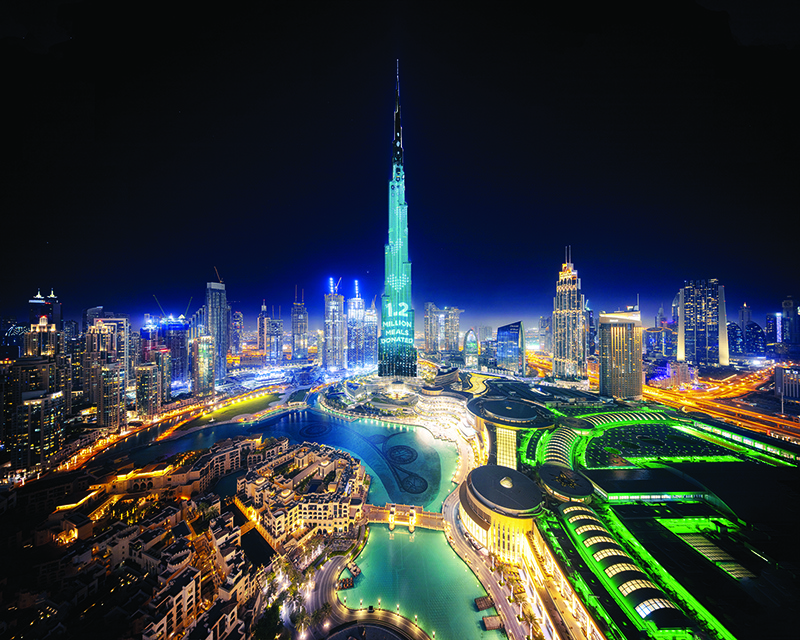
DUBAI: A handout image made available yesterday shows Burj Khalifa during a light show to mark the ‘10 million meals’ COVID-19 campaign. – AFP
DUBAI: The world's tallest building, Dubai's 828-metre Burj Khalifa, has become a glowing charity donation box, raising money for food for United Arab Emirates residents suffering the economic impact of the new coronavirus pandemic. Each of the tower's 1.2 million external lights was 'sold' for 10 dirhams ($2.70), enough to buy one meal. As donations came in, the tower 'filled up', and people could also bid to claim the light at the very top.
As the region's tourism and business hub with the world's busiest international airport, Dubai's economy has been hit hard by the coronavirus pandemic. Many people have lost jobs or had incomes reduced. Tens of thousands of migrant workers, who often live in crowded shared accommodation where the virus spreads more easily, have registered to be repatriated.
"Hope you have a good solid meal. We take things for granted but life has a way of teaching us how to wake up," said donor Shereen Harris in a public comment on the campaign's website. The UAE has recorded 19,661 cases of infection with COVID-19 and 203 deaths, the second highest death toll after Saudi Arabia of the six Gulf states.
The donation box has raised funds for more than 1.2 million meals so far, organizing body The Mohammed Bin Rashid Al Maktoum Global Initiatives (MBRGI) said. The fundraising drive is part of a campaign to fund 10 million meals for low-income families during the Muslim fasting month of Ramadan by MBRGI, patronized by Dubai's ruler and UAE Vice President Sheikh Mohammed bin Rashid Al-Maktoum.
The number of coronavirus cases in the six Gulf Arab states surpassed 100,000 on Monday, with 557 deaths, according to Reuters calculations based on official figures. Coronavirus infections in the energy producing region had initially been linked to travel. But despite taking early measures to combat the virus, Gulf states have seen a spread among low-income migrant workers living in cramped quarters, prompting authorities to ramp up testing.
Saudi Arabia, the largest Gulf state with a population of about 30 million, has the highest count at 41,014 infections and 255 deaths. It recorded 1,966 new cases and nine new deaths on Monday. The daily number of new cases in the kingdom first crossed the 1,000 threshold on April 18. Health authorities said in April the virus could eventually infect between 10,000 and 200,000 people in Saudi Arabia.
Elsewhere in the region, the tiny state of Qatar on May 5 overtook regional business hub the United Arab Emirates as having the second highest infection count among the six states. Qatar, where health authorities last Thursday said the outbreak had entered its peak, has recorded a steady increase in cases to 23,623 while the number of deaths has held steady at 14. The UAE total has so far reported 18,198 infections with 198 deaths.
Some Gulf Arab states eased anti-virus containment measures with the start of the Muslim holy month of Ramadan on April 24. The UAE and Saudi Arabia relaxed curfews that had been in place since mid-March. Saudi Arabia said on Thursday it had formed a police unit to monitor violations of its lockdown rules and banned gatherings of more than five people. Kuwait, where there has been a recent spike in the number of new cases, on Sunday imposed a full curfew for 20 days, exempting only essential services, instead of the 16-hour curfew that had previously been in place.
Dubai emirate, the UAE's tourism and business hub, allowed malls and dine-in restaurants and cafes to reopen with limitations on April 23. Some other emirates have followed suit. Saudi Arabia permitted commercial stores, including malls, to reopen on April 29 with restrictions until May 15. Qatar has maintained the closure of public venues with the exception of those providing essential services and goods. – Reuters











